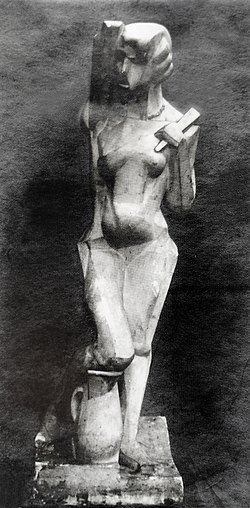Danseuse (Csaky)
| Danseuse (Femme à l'éventail) |
|
|---|---|
 |
|
| Artist | Joseph Csaky |
| Year | 1912 |
| Type | Sculpture (original plaster). Csaky photographic archives (AC. 110) |
| Location | Dimensions and whereabouts unknown (presumed destroyed) |
Danseuse, also known as Femme à l'éventail, or Femme à la cruche, is an early Cubist, Proto-Art Deco sculpture created in 1912 by the Hungarian avant-garde sculptor Joseph Csaky (1888–1971). This black and white photograph from the Csaky family archives shows a frontal view of the original 1912 plaster. Danseuse was exhibited in Paris at the 1912 Salon d'Automne (n. 405), an exhibition that provoked a succès de scandale and resulted in a xenophobic and anti-modernist quarrel in the French National Assembly. The sculpture was then exhibited at the 1914 Salon des Indépendants entitled Femme à l'éventail (n. 813); and at Galerie Moos, Geneva, 1920, entitled Femme à la cruche.
Danseuse is a plaster sculpture carved in a vertical format. The work represents a woman standing or dancing nude with a folded fan in her left hand and her right knee leaning on a vase. The sculpture, known from an early photograph, is executed in a highly Cubist syntax, in opposition to the softness and curvilinearity of Nabis, Symbolist or Art Nouveau forms.
The figure, at first glance delicate, feminine, wearing a necklace, graceful with a classical allure, is constructed with a series of faceted planar forms that together form a tight cohesive structure. The head, with its stylish coiffure, and the models facial features are simply constructed with only a few surface planes juxtaposed at seemingly right angles. Even the vase, upon close examination, appears treated in geometric terms, its sphericity broken by an angular cut to the right, barely visible in the photograph.
The treatment of Csaky's Danseuse, as other works by the artist executed between 1910 and 1913, suggests, as Albert Edward Elsen notes, that Csaky had looked not only at Picasso's earlier painting and sculpture, but also at African tribal masks whose exaggerated features and simplified design accommodated the need to be seen at a distance and to evoke strong feeling.
...
Wikipedia
